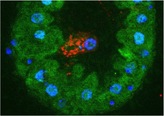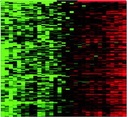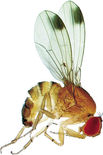Host microbe interactions
We aim to characterize the molecular mechanisms that control Host-Microbe interactions. We study both immune effector mechanisms and tissue repair mechanisms, as both are required to survive infection. We further integrate them in a quantitative holistic model to capture the complexity of host-microbe dynamics.
a- microbial pathogenesis, infectious damage and tissue repair

The damage inflicted by microbes to an host upon infection is central to Host-Microbe interactions. We try to characterize the nature of infectious damage (microbial or immune mediated) as well as the impact of this damage on host health. In addition, sensing of damage by the host can elicit different outcomes of the immune response and the infectious process. We therefore analyze how infectious damage impacts the host immune response. Finally, we study the mechanisms used by the host to dampen infectious damage or tolerate it, with an emphasis on tissue repair mechanisms.
image: caspase activation (red) in a damaged enterocyte that undergoes delamination (blue: nuclei)
image: caspase activation (red) in a damaged enterocyte that undergoes delamination (blue: nuclei)
b- immune effector mechanisms and quantitative control of the immune response

We first aim to identify new immune effector mechanisms as well as the regulatory mechanisms that control them, by genetic and genomic approaches. In addition, we start to characterize how known effector mechanisms work together in vivo. We integrate the different phenotypes in a quantitative model to understand their relative contributions and synergies. We are particularly interested in regulatory cross-talks between pathways controlling different facets of the immune response.
c- the immune response of insect pests to biocontrol agents

Drosophila suzukii, the spotting wing Drosophila is an invasive pest in both Europe and North America, that attacks a wide variety of fruit crops. We are studying the susceptibility of D. suzukii to a number of microbial agents in order to develop biocontrol strategies. D. suzukii, contrary to its relative D. melanogaster feeds on non decaying matter, such as soft fruits. We are also interested in understanding how the gut of D. suzukii has evolved to adapt to this very different lifestyle.